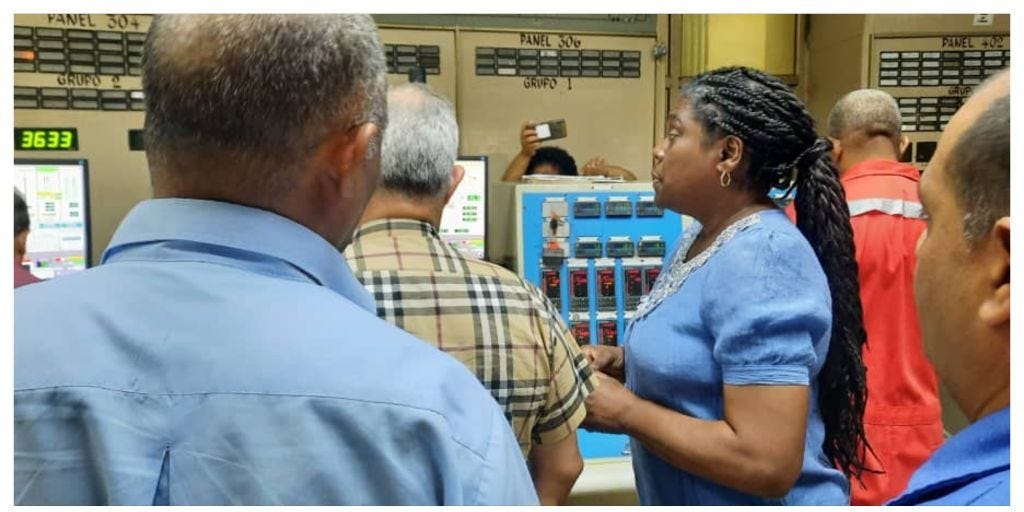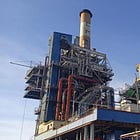The fourth power blackout in Cuba
Cuban transition to integrated renewable energy is progressing

On Friday, March 14, 2025, at 8:15 p.m., there was a breakdown in the Diezmero substation in Havana, which meant the fall of various generating units in western Cuba, which provoked the collapse of the National Electrical System. It was the fourth collapse of the Cuban National Electrical System in the past year.
At 8:30 a.m. on Saturday, on the national television daily news program “Buenos Díaz,” Lázaro Guerra Hernández, Director of Electricity of the Ministry of Energy and Mines, noted that, prior to the collapse, the national electrical system had been experiencing a deficit at the hours of peak demand, a situation which increases the risk of collapse. He reported that the recovery strategy involves the creation of microsystems of energy, with the intention of starting thermoelectric power plants by connecting them to the microsystems.
Miguel Díaz-Canel, the First Secretary of the Communist Party of Cuba and the President of the Republic, sent a message to the people mid-morning on Saturday, informing them that the government and the Party were working intensely for the recovery of the electrical system. He noted that he had been in constant communication with Vicente de la O, Minister of Energy and Mines, since the collapse of the system the evening before. He noted that energy microsystems had been established, by means of which power plants will be started.
In fourteen of the nation’s fifteen provinces, the creation of microsystems had begun on Friday evening, shortly after the collapse. The microsystems provide the area with a degree of stability, enabling the start of the power plants by means of the gradual connection of the microsystems to the plants. In establishing microsystems, priority was given to important areas, such as those where hospitals and water pumps are located.
In the Saturday morning news program, the Director of Electricity noted that ten of the nation’s fifteen provinces had microsystems functioning, but not including the City of Havana. Subsequently, by the beginning of Saturday afternoon, microsystems and small areas of energy were established in three of the fifteen municipalities of the City of Havana, including Central Havana.
By mid-morning Sunday, six thermoelectric power plants in different areas of the country had been started, which enabled the restoration of the electrical system from Havana in the West through the central and eastern provinces, although the western provinces of Artemisa and Pinar del Río remained disconnected from the National Electrical System. In the two western provinces, electric services to hospitals and wells were maintained by means of microsystems.
By Sunday afternoon, all the municipalities of the City of Havana had electrical services reestablished, although not all the circuits (the smallest area in the electricity grid). The Electric Company of Havana reported at 9:14 p.m. that 95% of the company’s electricity clients had their services re-established, and it reported at 10:06 p.m. that electric services in the city had been 100% restored. During the blackout, priority had been given to reestablishing electrical services and maintaining the supply of water and fuel in the forty-three hospitals of the city.
By 9:00 p.m. on Sunday, the entire National Electrical System was reestablished, although not all the circuits were energized.
During the blackout, the international airports of Cuba operated without any modification. Similarly, the national inter-provincial bus service operated in accordance with its established schedule.
The causes
As I reported in my October 25, 2024, commentary, the principal cause of these periodic national blackouts is the intensification of the U.S. economic, commercial, and financial blockade against Cuba, initiated by the first Trump administration as one front in the economic, ideological, and political war against leading anti-imperialist governments, an unconventional war that was initiated during the second Obama administration and continues to the present day. The front in Cuba involves targeting banks and companies in third countries that have transactions with Cuba, threatening and imposing fines and other sanctions against said banks and companies. The front resulted in the severing of Cuban relations with many commercial and financial partners, leading to shortages of supplies and materials necessary for agricultural, pharmaceutical, and light industrial production.
In addition, I noted in the October 25, 2024, commentary that the primary immediate cause of the blackouts is the shortage of fuel oil that the thermoelectric power plants require. And a secondary immediate cause is the lack of parts and supplies necessary for the maintenance of aging thermoelectric power plants.
Previously, I had posted on October 22 a description of life in Cuba during the seventy-two-hour blackout of October 18-21, 2024. I described the practical and good-spirited adaptation of the neighbors in our building to the situation, which included a degree of uncertainty with respect to what was occurring; and which included half-hearted and unsuccessful attempts in the nearby streets to generate protest.
I think that it can now be said that we’ve got this down. When the system collapsed on Friday evening, March 14, we were fairly sure that the national electrical system had collapsed. There had been no previous announcement, as has been the custom in recent months, informing people residing in particular electricity circuits that the electricity service was going to be turned off for three or four hours in order to reduce the consumption of electricity. Moreover, we could see from our fifth-floor balcony that the entire city was dark. We knew that, if the national electricity system had collapsed, as appeared likely, the government and the electricity workers would immediately undertake intensive work to create microsystems and use them to start thermoelectric plants, a process that would likely take a couple of days to cover the entire nation.
We settled into a routine. I worked on my laptop until the battery was exhausted, and then turned to reading, in this case a rereading of George Orwell’s 1984, which I had not read since high school. Olga Lidia and her friends in the building drank beer and played dominos. We had some information coming in through online connections and through contacts that some of the neighbors had with their places of work, confirming what we had originally thought.
There was no effort to stimulate a politically immature protest, as had occurred in October. The streets were completely tranquil, as were our neighbors in the building.
The electricity in our apartment was restored at 2:00 p.m. on Sunday. Since it had been less than forty-eight hours, the water tanks to our apartment did not run out of water, and our frozen chicken did not thaw. We have become accustomed to the inconvenience. For me, it is a small price to pay in support of the dignity of a neighboring nation,
§
The national plan of transition to integrated renewable energy
On March 19, 2025, the daily evening news program Mesa Redonda was dedicated to the government’s current project of installation of photovoltaic parks, a key dimension in a transition to the integration of renewable energy in the national electrical system and in the national system of production. Directors of the Ministry of Energy and Mines and the Electrical Union were participants in the Mesa Redonda panel.
By 2030, photovoltaic parks will produce 40% of the nation’s electricity, which will mean that the thermoelectric power plants can function entirely on Cuban fuel oil, eliminating the need for the importation of fuel oil in order to generate electricity. Four photovoltaic parks have been installed and operating, and four more will be completed by the end of the month. In addition, material for the construction of seven additional photovoltaic parks in six provinces arrived in Cuba on March 19, donated by the People’s Republic of China.
The national plan on energy transformation includes new legal obligations for private and public companies. All new companies authorized to do business are now required to invest in a small system of renewable energy, such as solar panels on the roofs of buildings. Established companies have five years to install a system of renewable energy.
The national plan for energy transition, which is supported by the Cuban Constitution and by Cuban laws, is developing an integrated system, which combines renewable energy sources with fossil fuel energy. And it is a comprehensive system, which not only is using solar energy in the production of electricity, but also is integrating renewable energy production in systems of agricultural and industrial production. In agricultural production, for example, biomass energy to power water pumps is being developed.
The national transition to integrated renewable energy also is being stimulated by eight-year exemptions from taxes and tariffs for foreign companies that invest in energy.
The Russian Federation also is contributing to the Cuban system of energy production, as was reported in the Cuban daily Granma on March 19. Russia is participating in projects for the repair, maintenance, and modernization of Cuban thermoelectric plants. In recent months, Russia has granted Cuba a credit of sixty million dollars to buy fuel, plus another two million dollars to acquire parts and supplies for the maintenance of thermoelectric plants. In addition, Russia has gifted seven wells to support Cuban production of petroleum.

Final considerations
As I have maintained in previous commentaries, the Cuban government and the Party are responding to the economic crisis, provoked by the US unconventional war, with an intelligent national economic plan that seeks to reduce vulnerability to the recent U.S. maneuvers. They have the support of the people. Almost no one in Cuba thinks that their lives would be improved by “regime change.” The people want the war to end, but the Party is declaring that the people and the Party together must defeat the blockade without it being ended. If the government of the United States truly wanted to support the Cuban people, it would end the blockade. It is, far and away, the fundamental demand of the Cuban people.
A free subscription option is available, with capacity to read, send, and share all posts. A paid subscription ($5 per month or $40 per year) enables you to make comments and to support the costs of the column; paid subscribers also receive a free PDF copy of my book on Cuba and the world-system. Ten percent of income generated through subscriptions to the column is donated to the Cuban Society for Philosophical Investigations.
Deepen your understanding of people’s democracy, a post-bourgeois form of democracy necessary for our times:
People’s Democracy in Cuba: A vanguard political-economic system






